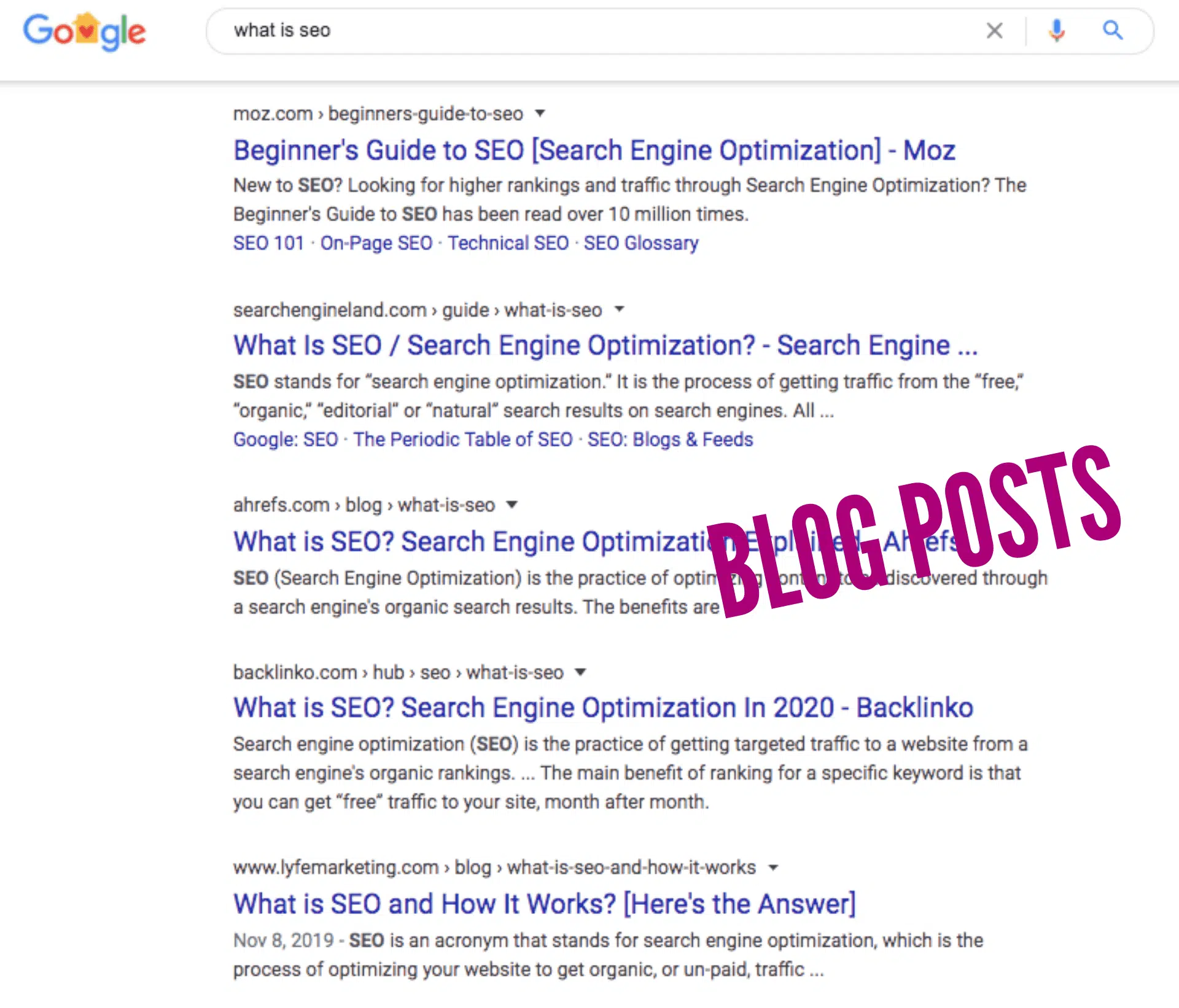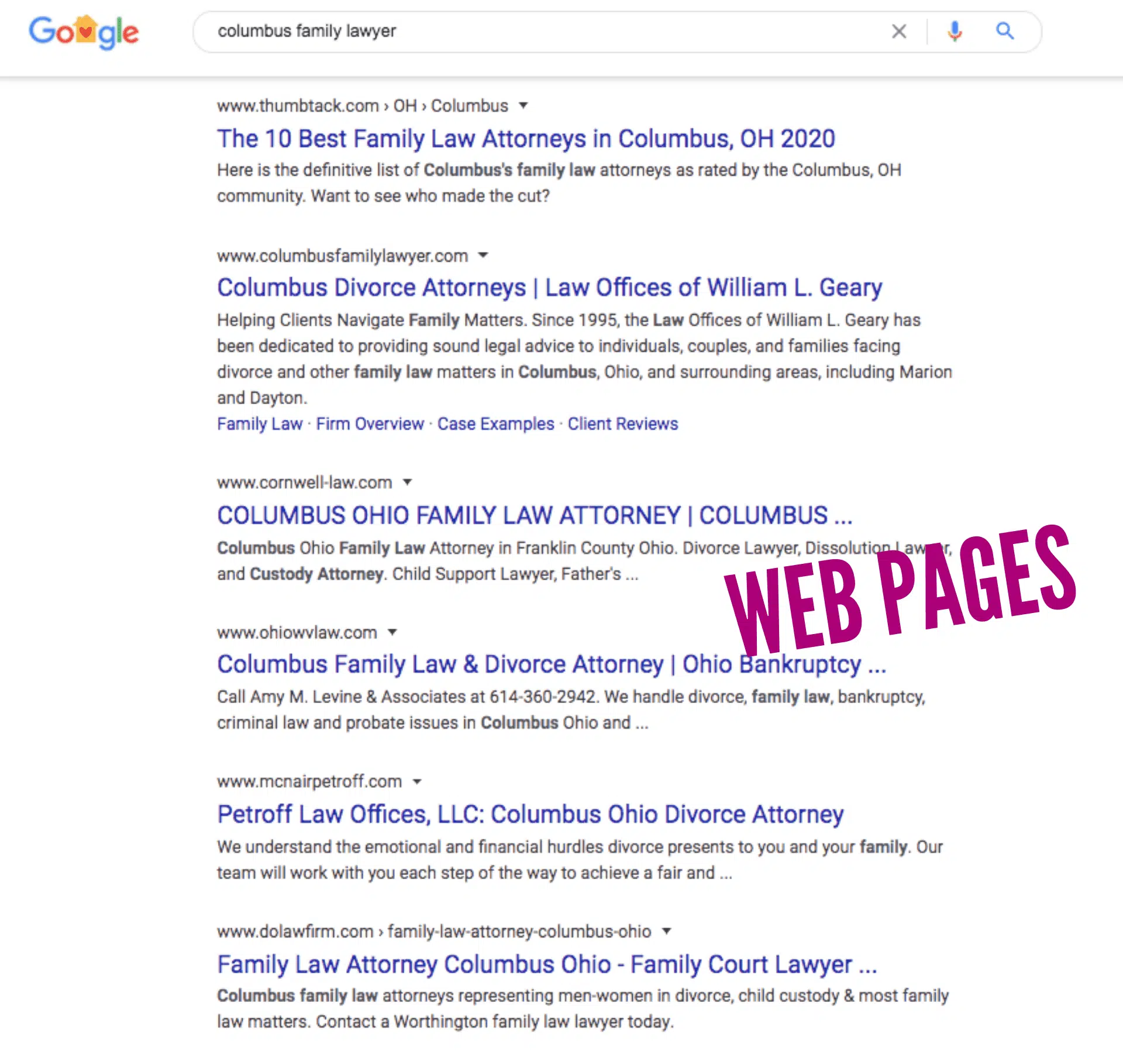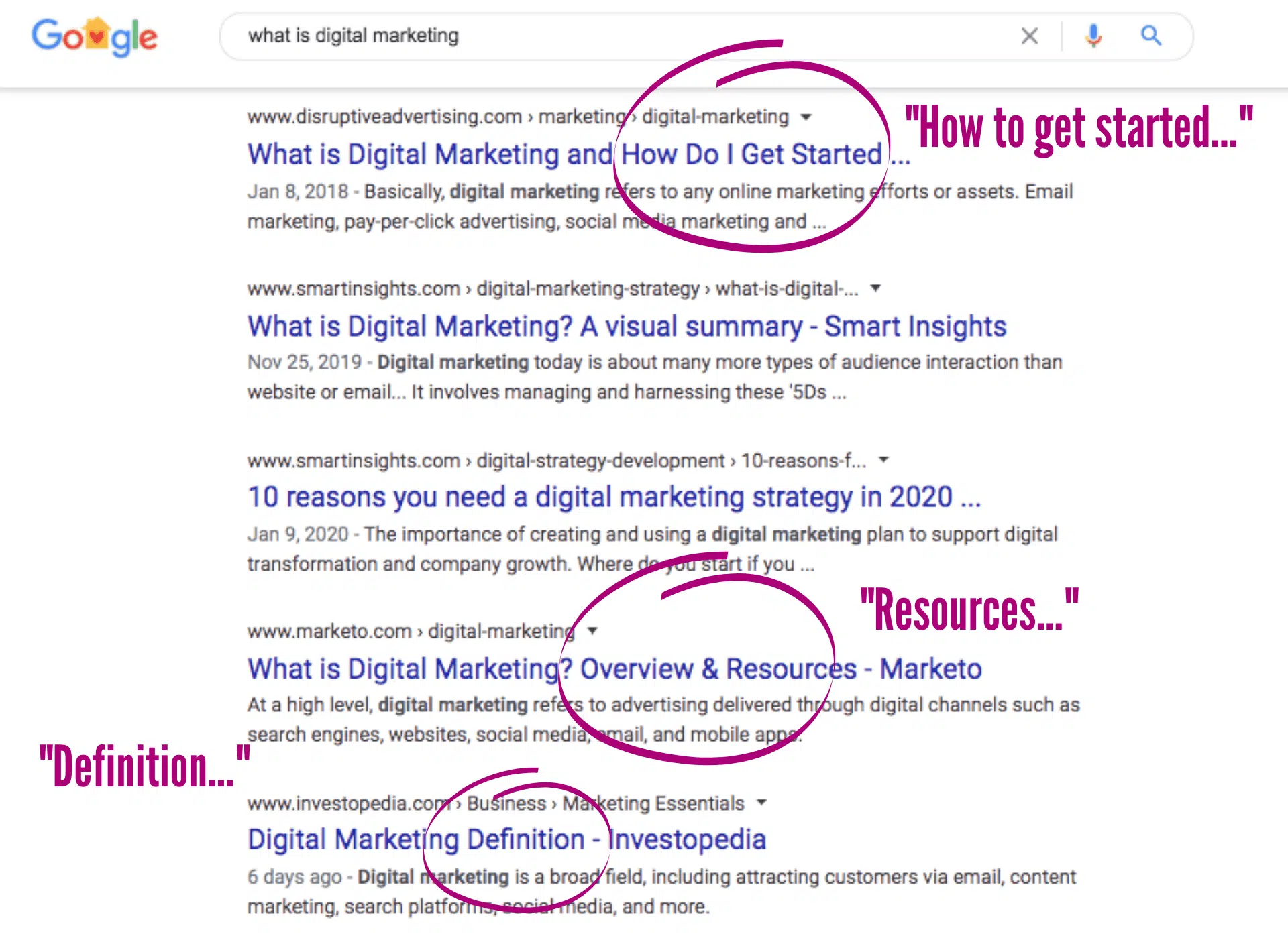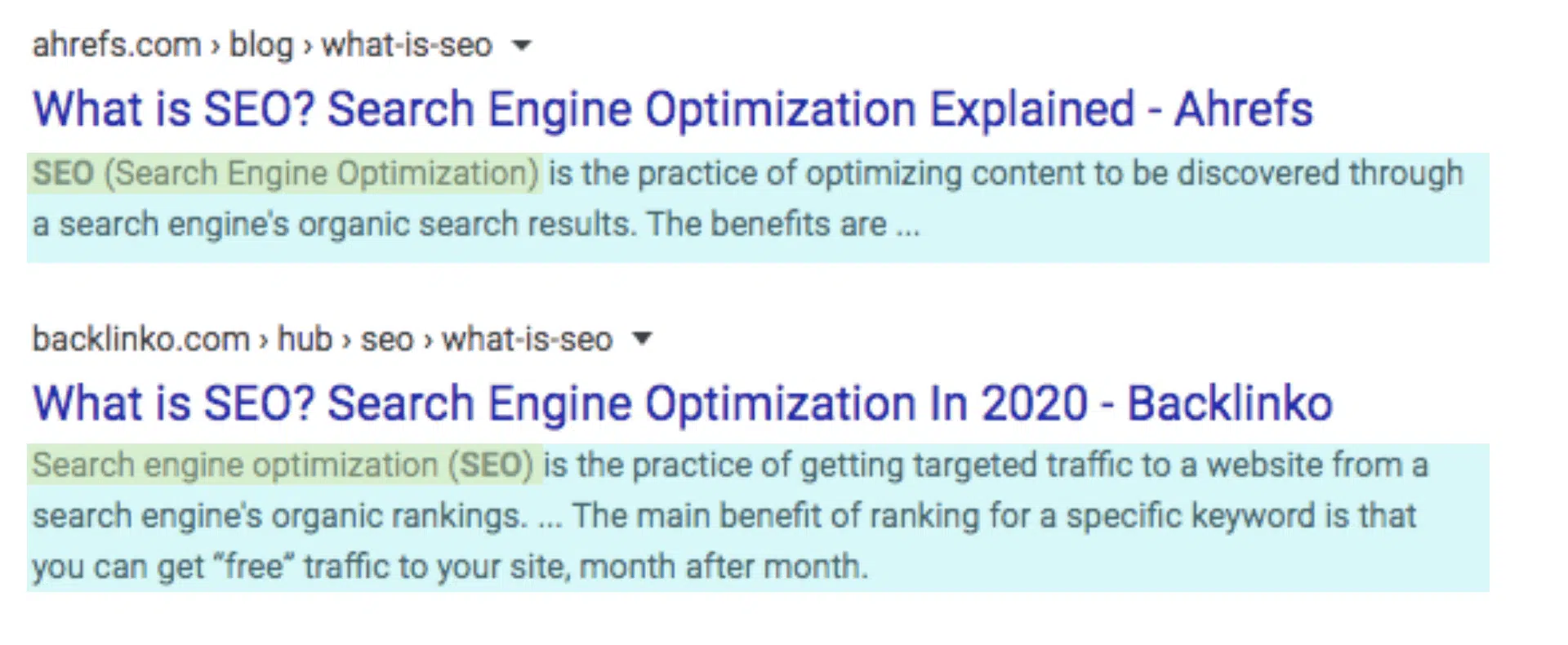The term “SEO copywriting” has been buzzing around online for quite some time, but there is still a bit of mystery to what SEO copywriting really is and how to do it right.
At first glance, it may seem obvious that SEO copywriting is about writing for search engines – but it’s so much more than that. Great SEO content goes far beyond pleasing the Google gods or even including the right number of keywords.
This misconception leads many people to think that they have to be an SEO pro in order to write content that attracts organic traffic. In reality, SEO copywriting isn’t complicated once you know that the primary goal is to write for people first, before the search engine algorithms.
Want to know what it takes to write user-friendly, search engine optimized content?
Here’s what you’re going to learn in this guide:
- What is SEO Copywriting?
- Why SEO Copywriting Matters
- Elements of SEO Copywriting
- How to Write Content For People (and Search Engines)
- SEO Copywriting Techniques to Engage Your Readers
Let’s dive in.
What is SEO Copywriting?
SEO copywriting is a form of online content writing that involves optimizing web content for select keywords in order to drive traffic from search engines. This content contains key phrases users are actively searching for in order to find information online.
Therefore, the art of SEO copywriting involves writing content that best fits what the user is trying to find when they search for a specific keyword. Writing user-friendly, keyword-focused content can help websites rank higher in the search results and drive organic traffic.
Learn more about the definition of SEO copywriting in this video:
How is SEO Copywriting Different from “Traditional” Copywriting?
Now, SEO copywriting differs from traditional copywriting in that the initial goal with SEO copywriting is to attract organic traffic. Traditional copywriting is primarily focused on converting traffic into leads and sales, and doesn’t necessarily involve search engine optimization.
An SEO copywriter conducts keyword research and crafts content that will attract more users to a website.
A regular copywriter, on the other hand, conducts market research to determine what copy will compel existing or new traffic to convert (sign up, buy, etc.).
What Helps Content Rank in the Search Results?
The key to writing content that ranks in the search results is focusing on the user before the search engine algorithms. By creating content that best fits what the user is searching for, you increase your chances of improving your rankings and attracting traffic.
However, this is just the tip of the iceberg when it comes to SEO copywriting. Let’s discuss the distinction between “writing for people” vs “writing for Google”.
Writing for People vs Writing for Google
When you do a search for “what is SEO copywriting” you’re likely to see articles that define it as the process of “writing for Google” or search engines in general. On the flip side, you’ll see other articles highlighting the need to “write for people”.
Writing for Google:
To write content and optimize it to satisfy Google’s ranking factors. In other words, your goal here is to use keywords and format your content in just the right way so that it can get picked up by search engine algorithms.
Writing for People:
To write content that suits what your target audience is searching for. Here, the aim is to provide value, answer common questions, and/or help readers accomplish a goal. If you’re solely focused on writing for people, your content may or may not be optimized for search engines.
Why Not Both?
In reality, SEO copywriting is kind of a dance between writing for Google and writing for people.
Obviously, you want to write content that your target audience wants to read, but your content also needs to be optimized so it gets displayed in search engines to begin with. If your content doesn’t rank, it won’t get found; if it’s not user-friendly, readers won’t engage with it (by subscribing, buying your products, etc.).
I’ve spent several years testing the effects of optimizing content for Google vs writing for people, and the very best content is always content that considers both. You want rankings and traffic as much as you want engagement and conversions.
Now:
Writing for both is not always easy. In my experience, between tend to focus on the algorithms at the expense of the user. Since your goal is (likely) to make money with your content, you’ll want to be sure it’s going to speak to your target audience and entice them to take action.
Why SEO Copywriting Matters for Your Website
SEO copywriting matters for your website because it encompasses both parts of the equation of 1) attracting traffic and 2) converting traffic into leads/customers.
Even the most “optimized” website will struggle to turn traffic into buyers if it doesn’t have compelling content that speaks to the users’ needs, communicates the value of the offer, and calls users to take action.
At the same time, your website could have amazing content, but if it isn’t optimized for search engines, it won’t work to attract organic traffic.
Whether you get started with SEO copywriting yourself or choose to hire a professional copywriter, having search engine optimized copy on your website is absolutely essential if you want to generate organic traffic that converts.
More reasons why SEO copywriting matters:
- Creates on-brand content that helps you stand out from the competition
- Opens up a new traffic channel by attracting users from search engines
- Communicates the value of what you offer and why visitors should buy from/work with you
- Establishes authority through high-value, well-researched content
- Creates engaging content that drives social shares and other types of engagement
- Attracts backlinks from other high-authority websites
If you’re simply writing content and posting it up on your site – or crafting content that’s chocked full of keywords to trick the algorithm – then you will struggle to see the traffic and conversions you deserve. SEO copywriting is an essential part of any well-rounded SEO strategy.
“Mastering the art of SEO content writing can be the difference between attracting a few website visitors and creating dedicated customers” – Jessica Foster
Don’t have a website yet? Create a website with free hosting and your own free domain name with WordPress.
7 Elements of SEO Copywriting
So, we know what SEO copywriting is, but how do we do it?
The important thing to note is this: SEO copywriting is about way more than stuffing your content full of keywords. Yes, keyword research and keyword usage are involved, but how you use them is way more important than how many you use.
To keep things simple, I’ve outlined the 7 elements of SEO copywriting so you can work through this process time and time again to create your best SEO content ever.
1. Keyword Research
If you want your content to generate organic traffic, you’ll need to identify keywords that have ample search volume. If you write content for a keyword that gets 0 searches per month, it’s unlikely that you’ll attract any organic visitors.
So, keyword research is all about finding keywords that actually get searched for AND that are not too competitive for your website to rank for. Competition level is important here because if there are many websites ranking for a particular keyword, it will be hard for your new/small website to outrank them.
Further, you’ll want to identify keywords that are actually relevant to your audience and what your business offers. Just because you CAN rank for a certain keyword, doesn’t mean you should.
You should conduct keyword research for your content strategy to find terms your audience is actually searching for and that are low competition enough that your website can outrank the existing competition.
I like to use keyword research tools like SEMrush to find the best, high-traffic keywords for my blog.
2. Content Planning
Once you’ve identified a list of keywords that you want your website to rank for, it’s time to plan out your content. This step is important because not every keyword is suitable for a web page or a blog post.
Look at your list of keywords and do a Google search of each one. Note what the search results look like: Are they blog posts? Web pages? Reviews? Homepages? This will give you some idea as to what type of content you should create.
Most informative keywords (like “what is…”, “how many…”, “how to…”, etc.) are suited as blog posts where you can offer a more in-depth explanation of the topic.
Other keywords (like “____ services”, “best [provider] in [city]”, “hire a [provider]” etc.) are best suited as web pages where you can list the services or products you provide.
Keep this in mind when planning out your content. You will want to map your keywords to the type of content users would *expect* to see when they search for that keyword.
3. Content Writing
Now the fun part (in my opinion): writing the content!
If you don’t consider yourself to be a great writer, this step may be a struggle for you. Since SEO copywriting is a type of marketing, I highly recommend outsourcing content writing if it is not your strong suit. It will be more effective and you can spend your own time focusing on other areas of your business.
If you ARE a good writer, then this step is just a matter of writing content that’s going to be of value to the user AND suits the focus keyword you have chosen for the piece.
For example:
If your keyword is “what is digital marketing”, then it should be obvious that your blog post defines what digital marketing is. You might also list the essential elements of digital marketing and introduce some strategies for how readers can get started.
If you are totally stumped on what to write about, check out the ten pages that are currently ranking for your chosen keyword. What topics have they covered? Are they missing anything? Can you find ways to make your content even better?
For example, the focus of this piece is “SEO copywriting”, which is a relatively competitive keyword. But after looking at the top-ranking pages, I decided to add more value by covering the “elements of SEO copywriting” and some additional SEO copywriting techniques. I also made a video for good measure.
Your goal:
To speak to whatever you suspect the user was looking for when they searched for your target keyword. Make sure your content is well-researched, accurate, and engaging. If you can write content that provides more value than the top-ranking pages, even better!
4. Optimization
In case you hadn’t noticed already, the general SEO copywriting process involves writing for users first, THEN optimizing for search engines. If you aren’t writing content that provides value to your readers, then what’s the point? You can always optimize your content, but you can’t shoehorn “value” into an existing post.
Note that over time it will get easier to write and optimize at the same time. You’ll have a better idea of how to use keywords, how to structure your content as you write, etc. But, to get started, it’s okay if this is a two-step process.
Keyword Usage
Use your target keyword in the title (title tag) of your post or page. It’s also recommended that you use it in the URL and in the introduction. You’ll also want to use it *naturally* throughout the body of your content.
Headings
Your H1, H2, and H3 headings are all areas where you can include your target keyword or related (similar) keywords. You do not (and should not) use your target keyword in every single heading – this is overdoing it and will just come across as spammy. Look at the headings of this blog post as a good example.
Meta Data
You can also use your target keyword or related keywords in the meta description of your post/page. Keep in mind that this is the text that users see displayed under the title in the search results, so it should accurately explain what the content is about and entice users to click through to your website.
Also, you can use keywords in the alt text of your custom images if they are relevant to what the image is about. This text is picked up by e-readers and also tells search engines what’s included in the image. This is not a place to just stuff the alt text full of keywords.
Internal / External Links
Finally, you’ll want to link to other pages on your website to keep users on your site as long as possible. You’ll see throughout this post that I link to other resources (like my keyword research guide and service pages) so readers can find more information. This is a great way to direct users to other content on your site.
You can also link to external websites if their content provides some type of value to your post. Studies, comprehensive guides, reviews, and interviews are all great sources to link to. I just wouldn’t recommend linking to a direct competitor or to a page that’s also targeting your chosen keyword.
5. Accessibility
Accessibility is one component of on-page SEO but it is worth mentioning here. If your website is not accessible (loads slowly, is hard to navigate, isn’t mobile-friendly, etc.) no amount of great content is going to get your website to rank. You need every piece of the puzzle.
Make sure your website loads quickly, has straightforward navigation, and is accessible from mobile devices so you can 1) rank high in the search results and 2) keep users on your website for longer.
6. Backlinks
While content may be “king” (as they say in the SEO industry), backlinks are still very important. If you can attract links from other reputable sites, this will make your content even more effective.
A backlink from a website is essentially a vote of confidence that your site is a good source of information. By adopting a link building strategy, you can improve the rankings of your content and generate even more traffic.
7. Content Marketing
Once you publish a new blog post, it can take some time to start seeing the organic traffic roll in. But you don’t have to just sit there twiddling your thumbs. If you create a content marketing strategy, you can generate traffic from multiple channels.
I like to share my latest posts on social media (Facebook, Twitter, and LinkedIn), send them out to my email list, and turn them into scripts for my YouTube videos (I use TubeBuddy for YouTube keyword research). In doing so, I start getting traffic right away, even while I am waiting for Google to pick up my post.
How to Write Engaging Content That Ranks Well in Search Engines
To reiterate, the goal of SEO copywriting isn’t to only generate traffic from search engines but to turn that traffic into leads or customers. That means that you should be publishing engaging content that compels users to take action.
Once you have written user-friendly content and have optimized your content, you should include calls-to-action (CTAs) that entice readers to subscribe, buy, sign up, call you, etc.
Example:
That may mean including a contact form within your post, adding a “Subscribe to our newsletter” call-to-action, or referencing some downloadable content like an ebook or PDF. You should give users multiple opportunities to opt-in and convert on your website.
In a nutshell:
Content that is engaging and keeps users on your website will indicate to Google that your content is worth reading and therefore worth ranking in the search results. Over time, your writing and optimization skills will get better and better to the point that SEO copywriting becomes like second nature!
SEO Copywriting Techniques to Engage Your Readers
Know that SEO copywriting takes practice and that you shouldn’t expect to be a pro right away. Some of the best things you can do to improve your skills are paying attention to what your audience is interested in and tracking the results of your content.
Having analytics set up on your site will allow you to identify which content is performing best so you can create similar content in the future. Learn from what’s working, tweak what isn’t, and listen to your audience when they tell you what they would like to see.
Here are three bonus SEO copywriting techniques to help you get the best results from your content.
1. Repurpose your content.
When you publish a new post, think of different ways you can market that content across several channels. That might mean posting a portion of your content as an article on LinkedIn, sharing some tips in a Facebook Live video, turning the post into a downloadable ebook, or sharing it to your email list as a 5-day email course.
2. Publish roundup posts.
A roundup post is a post where you “round up” tips/advice from multiple sources and compile them into a single guide. This is usually done by interviewing industry experts and publishing a post like “X Experts Share…”. Once live, you can ask those featured in your post to share the post, broadening your reach and potentially earning you some new backlinks.
3. Submit guest posts.
Reach out to industry-related websites to submit guest articles in order to drive links and traffic back to your website. I like to write guest posts that are relevant to similar articles I have on my own site so I can link to the source and attract traffic from the site I am guest posting on. Many websites will allow you to do this for free; just make sure it’s a reputable website.
Get Started with SEO Copywriting for Your Website
Want to start attracting more traffic and leads to your website? SEO copywriting is one way to get your website ranking higher in the search results AND turn that traffic into customers. Anyone can get started with SEO copywriting as long as they strive to write for their target audience and follow best practices for optimizing their content.
Join the free WriteToRank Facebook Group for even more tips on how to optimize your content, get more traffic, and turn that traffic into leads.









